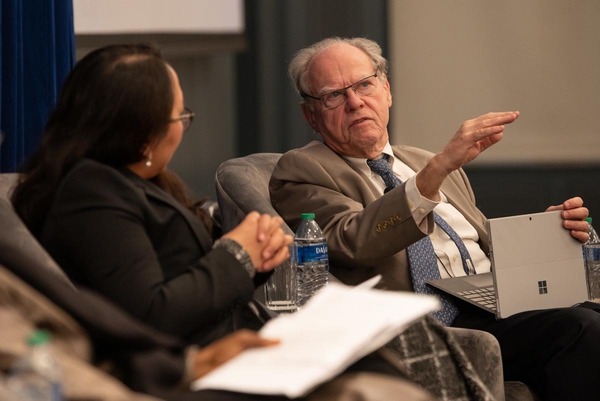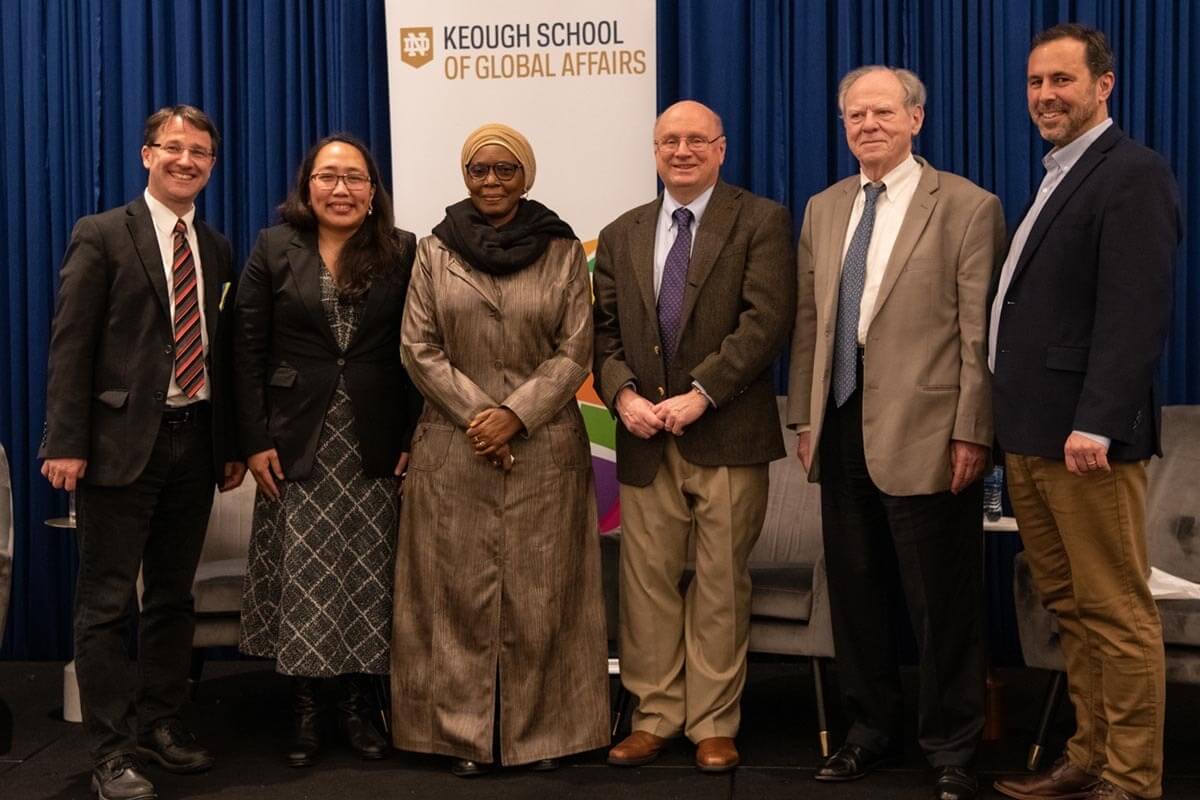
How does the concept of human dignity figure into decisions made by the European Court of Human Rights (ECHR)? How have the judgments of this international court in Strasbourg — established in 1959 with responsibility for interpreting the European Convention on Human Rights — shaped legal, political, or even popular understandings of human dignity? These were among the questions that arose during a conversation between András Sajó, a former ECHR judge, and Clemens Sedmak, director of the Nanovic Institute for European Studies and professor of social ethics. Their discussion on “Human Dignity in Europe” was part of the 2022-23 Dignity and Development Conference sponsored by the Keough School of Global Affairs that took place on March 2-3, 2023.
A conversation centered on human dignity
Sedmak explained that his inspiration for the conversation with a high-level European jurist was the connection between human dignity in Europe and the Nanovic Institute’s mission, as well as the focus of the Keough School’s conference. The ECHR comprises 46 judges, one from every state that is party to the Convention on Human Rights. It receives several thousand hearing applications per year from individuals in Europe or those affected by a measure taken by a European state. In this way, the individual, not the state, is placed at the center of the legal process, giving them recourse against domestic measures and domestic judgments.
As someone who could enrich a conversation about the ECHR and the promotion of human dignity, Sajó was the ideal invitee. A native of Hungary, he is an educator as well as a jurist. Currently University Professor at the Central European University in Vienna, he has been a visiting professor at leading universities in North America and Europe, consulted for international agencies such as the World Bank and the United Nations Development Program, and published extensively on constitutionalism, the rule of law, and illiberal democracies. Sajó served as a judge at the ECHR from 2008 to 2017, a tenure that included two years as a court vice president.
Milestone cases and their relationship to human dignity
Sajó and Sedmak’s conversation ranged from the dynamics behind dissenting opinions to the relationship between judges and the challenges of state compliance. In particular, the conversation focused on how the Strasbourg Court has considered the principle of human dignity in several milestone cases.
At the outset, Sajó emphasized the potentially surprising fact that the European Convention on Human Rights does not explicitly mention “dignity” in its foundational text. This omission, he said, is a strange one, given that the convention was largely written in response to the Universal Declaration of Human Rights (1948). In that declaration, “dignity” (in relation to the human person) is mentioned in both the Preamble and Article 1. It is also surprising because of the power that human dignity can wield within ECHR deliberations. “I recall,” Sajó explained, “that this is used as an argument when you would really like to silence others, or you would really like to silence a state. It is the ultimate idea. It is really inconvenient to argue against dignity.”

The case of Pretty vs. the United Kingdom (2002) helped Sajó illustrate the point that even while human dignity is a powerful ideological concept, its legal imprecision means that the court’s responses to a claim that an individual’s dignity has been violated have varied. Diane Pretty, who suffered from an incurable, degenerative motor neuron disease, had petitioned the UK’s High Court to protect her husband from prosecution if he assisted in his wife’s suicide. When her claim was denied by the British court, Pretty applied to the ECHR citing the British court’s violation of her human dignity.
In its unanimous decision, the European court agreed that Pretty’s case was admissible as a matter of dignity in the sense of self-determination, but it found no violation of the Convention and denied her case. Sajó explained that the court’s recognition that human dignity underpins all rights is ideological, but in practice, there are specific rules around how the Convention on Human Rights is interpreted and legally applied. Pretty’s case was denied, in part, because the Convention does not spell out a right to die.
It is the ultimate idea. It is really inconvenient to argue against dignity.
— András Sajó
To counterbalance any implication that human dignity carries no weight in the European court, Sajó explained that when it comes to torture and inhuman and degrading treatment, the court’s interpretation of the Convention provides sufficient protection of dignity. To demonstrate, he discussed a case concerning prison conditions and the personal space to which an individual is entitled. Responding to an application from a 72-year-old incarcerated man, the majority of the court found that if his personal space was 3 square meters, this was adequate and humane. The court reasoned that the applicant could leave his cell at certain times to visit the basketball court.
Sajó dissented from this judgment and felt that such treatment was undignified, cruel, and unusual, and noted that the court was failing to recognize the particularities of a petition by an older man who was less likely to participate in a basketball game. As regards the court’s consideration of human dignity, Sajó made the point that the majority’s acknowledgment that the basketball court offered the applicant a respite from his cell betrayed its recognition that a 3-square-meter confinement violates human dignity. Although this judgment, in Sajó’s opinion, did not protect the dignity of the individual, the principle of dignity was still at the heart of how the case was deliberated.
These cases show that while the Strasbourg Court might be ideologically committed to the supreme importance of the protection of human dignity, the judges’ role as interpreters of the Convention on Human Rights — which does not explicitly mention “human dignity” — leads to a certain arbitrariness in how they enact human dignity in practice.
The centrality of hope as an expression of human dignity
Within the court at Strasbourg, the ideological commitment to human dignity must contend with pressures from member states, rules around interpretation, and understandings of “the spirit” of the convention that might be shaped, as is human nature, by the judges’ personal beliefs. But Sajó’s discussion reflected that many judges still hold a conviction — often, as Sedmak noted, deeply philosophical — that every human retains the right to insist upon their dignity and to hope that it will be protected.
Sedmak illustrated this point by quoting from an ECHR opinion, which Sajó was party to, on the topic of life sentences for incarcerated persons. “Long and deserved though their prison sentences may be, they retained the right to hope that someday they may have atoned for the wrongs which they have committed, they ought not to be deprived entirely of such hope. To deny them the experience of hope would be to deny a fundamental aspect of their humanity and to do that would be degrading.”